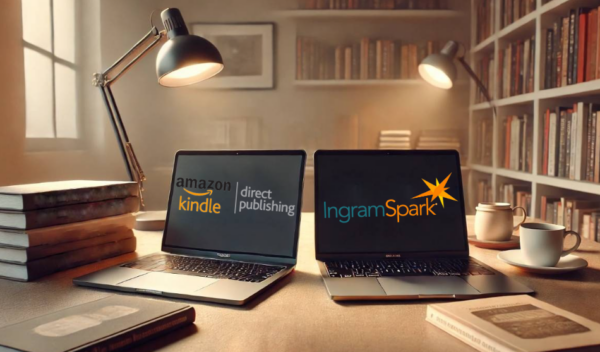The world of book distribution is evolving at lightning speed. Gone are the days when getting your book into a physical bookstore was the pinnacle of success. With global e-book sales projected to hit a whopping $23.12 billion by 2026, it’s clear that readers have fully embraced the digital revolution. And, let’s face it—when was the last time you strolled into a bookstore to buy a paperback instead of downloading an e-book in your pajamas? The rise of e-books and audiobooks has completely changed how books are sold, offering authors—both traditional and indie—the chance to reach a global audience without ever leaving their home office.
The truth is, if you’re an author today—whether you’re team traditional publishing or flying solo as an indie—you need to get comfortable with the future of book distribution to keep up. Nearly 45% of all book sales worldwide now happen online, so if you’re still dreaming about seeing your novel on a bookstore shelf, it might be time to add ‘mastering digital distribution’ to your to-do list. From AI-driven recommendations to machine learning tools that help readers discover new titles, the way books are found, sold, and consumed is undergoing a major transformation.
Your Publishing Journey Awaits – Start NowBut what does this mean for you as a writer? In this article, we’ll dive into the trends and innovations shaping the future of publishing, and more importantly, how you can use them to grow your readership and boost your book sales. Because, at the end of the day, the goal is to get your book into as many hands—or ears—as possible.
How the Publishing Industry is Shifting
The publishing industry has undergone a significant transformation over the course of the past decade, driven by technological advancements and shifting consumer preferences. Traditionally, authors relied on big publishing houses to get their books into the hands of readers. These publishers controlled the entire process—from editing to printing to distribution. However, today’s landscape looks very different thanks to the rise of self-publishing and indie publishers.
Self-publishing has become a powerful option for authors who want more control and faster turnaround times. Did you know that the number of self-published titles grew by over 40% between 2019 and 2022? Platforms like Amazon Kindle Direct Publishing (KDP) and IngramSpark allow authors to bypass traditional gatekeepers and publish directly to a global audience. In fact, independent authors now account for over 30% of e-book sales on Amazon!
This shift means the publishing process is no longer in the hands of just a few major players. Indie publishers are also making waves by offering more flexible, personalized services, catering to specific niches, and allowing authors more creative freedom.
AI and Traditional Publishers Adapting to Change
While self-publishing is booming, traditional book publishers aren’t standing still. Many are adopting new digital tools and technologies like artificial intelligence (AI) and machine learning to streamline processes. For instance, AI can handle tasks like proofreading and even help design book covers based on market trends and audience preferences. According to a report, AI-based cover designs have increased book sales by an estimated 20% due to their ability to target specific demographics.
Traditional publishers are also expanding distribution channels beyond physical bookstores, allowing authors to reach a wider audience of readers through e-books, audiobooks, and global digital platforms. This means that even traditionally published authors are reaping the benefits of these technological advancements.
Challenges and Opportunities
While these innovations are exciting, they’ve also made the market more competitive. With over 1.7 million books self-published in the U.S. alone last year, it’s getting harder for authors to stand out. However, those who can leverage niche markets and build strong reader communities through social media and online book clubs are finding success, even without the backing of a major publisher.
As the publishing industry continues to evolve, one thing is clear: embracing new trends and new technologies, is essential for both traditionally published and self-published authors who want to stay relevant in today’s competitive market.
Book Sales in the Digital Age
The digital age has reshaped nearly every industry, and book sales are no exception. In recent years, the way readers purchase, consume, and discover books has shifted dramatically, with e-books and audiobooks at the forefront of this transformation. Traditional printed books, once the dominant format, now compete with the rapid growth of digital alternatives.
The Rise of E-Books and Audiobooks
E-books have become a staple in the publishing world. With e-book sales accounting for over 20% of global book revenue in 2023, it’s clear that readers appreciate the convenience of accessing their favorite titles on digital devices. According to recent statistics, e-book sales are expected to reach $23.12 billion by 2026, driven by increased smartphone and tablet usage. Genres like romance and fantasy have particularly thrived in digital formats, allowing readers to devour entire series with ease.
Your Publishing Journey Awaits – Start NowAudiobooks are also experiencing a boom, with sales in the U.S. alone growing by over 25% annually. This growth can be attributed to the rise of platforms like Audible and Apple Books, which allow readers to consume stories while on the go. Audiobooks offer a unique way for publishers to capture a new audience, and for many readers, they’ve become the preferred way to enjoy books.
The Decline of Printed Books? Not Quite
While e-books and audiobooks are gaining popularity, printed books still hold a significant place in the market. Many readers continue to prefer the tactile experience of flipping through a physical book. In fact, printed books accounted for around 65% of all book sales in 2022, showing that the demand for traditional formats is far from over.
That said, the way printed books are distributed has evolved. Independent bookstores, once facing extinction, are seeing a resurgence, with sales increasing by 6% in recent years. Online marketplaces like Amazon continue to dominate, but readers are also returning to smaller, specialized bookstores for a more personalized experience.
The Impact of E-Commerce on Book Sales
E-commerce has completely revolutionized the way books are sold. With platforms like Amazon, authors—whether self-published or traditionally published—can reach a global audience with the click of a button. In fact, nearly 45% of all book sales now occur online. This accessibility has been a game-changer, allowing new voices to emerge and established authors to expand their reach beyond local markets.
In today’s digital age, book sales are no longer confined to physical bookstores. The combination of e-books, audiobooks, and online sales channels has made books more accessible than ever before, giving authors countless opportunities to connect with readers worldwide.
New Distribution Channels and Their Impact
As the publishing world evolves, so do the ways in which books are distributed. Traditionally, authors and publishers relied on physical bookstores to get their books into readers’ hands. However, in today’s world, digital platforms and new distribution channels are transforming the landscape, giving authors more control over how their work is shared and consumed.
The Rise of Online Marketplaces and Direct-to-Consumer Sales
Online marketplaces like Amazon and Barnes & Noble have become the dominant players in book distribution. In fact, Amazon alone accounts for nearly 50% of all U.S. book sales. These platforms allow both traditionally published and self-published authors to reach a massive audience without needing a physical bookstore presence first book itself. Self-published authors, in particular, have benefitted from these platforms, as they can list their books globally with minimal upfront costs.
In addition to online bookstores, many authors are opting for direct-to-consumer sales, where they sell books directly from their own websites or through social media platforms. This approach allows authors to build a personal connection with their target audience, while maintaining a higher share of profits, as they’re not relying on a third-party retailer. Authors who take this route can also offer exclusive content, signed copies, or bundled deals to entice buyers.
Subscription Services: Changing the Game for Book Distribution
Another trend shaking up book distribution is the rise of subscription services like Kindle Unlimited and Scribd. These platforms allow readers to pay a monthly fee for unlimited access to a library of books, similar to how Netflix operates for movies and TV shows. For authors, this offers a new way to reach readers who may not want to commit to buying individual titles.
While subscription services can be a great way to build a readership, they’re not without their challenges. Many authors are concerned about the royalty structure, which can be less favorable than traditional sales. However, for indie authors looking to increase their exposure, being part of these services can be a valuable tool.
Social Media and Community-Driven Distribution
The rise of social media has opened up even more possibilities for book distribution. Platforms like Instagram, Twitter, TikTok, and even YouTube have become crucial tools for promoting books. Hashtags like #BookTok on TikTok have driven significant book sales, especially for certain genres like romance and fantasy.
Your Publishing Journey Awaits – Start NowAuthors are now able to create communities around their books, leveraging influencers, book clubs, and reader-driven discussions to boost awareness and sales. This kind of grassroots marketing has led to viral book sales and allowed indie authors to compete with major publishing houses without the need for big marketing budgets.
Expanding the Reach Through Global Digital Distribution
Digital distribution allows authors to reach global audiences faster and more efficiently than ever before. Services like IngramSpark and Draft2Digital help authors distribute their books to countless international retailers, including Apple Books, Kobo, and Google Play.
This type of global access was unimaginable just a few decades ago. Now, authors can distribute e-books and audiobooks worldwide, allowing them to tap into markets they may never have considered before. Whether it’s a first-time author or an established name, the ability to reach readers across borders is one of the most exciting developments in the future of book distribution.
These new distribution channels are reshaping the way authors connect with their readers, offering more flexibility, reach, and opportunities to build a loyal fan base.
Trends in Graphic Novels and Visual Content
In recent years, graphic novels and visual content have surged in popularity, becoming a significant force in the book distribution market. With their unique ability to combine storytelling with visual artistry, graphic novels appeal to a broad range of readers, from children to adults. This genre’s growth reflects changing reader preferences and offers new opportunities for authors, artists, and publishers alike.
The Growing Demand for Graphic Novels
Graphic novels have seen an impressive rise in sales over the past decade. In 2022 alone, graphic novel sales in the U.S. grew by more than 10%, and the genre now accounts for billions in revenue globally. Genres like superhero stories, fantasy, and even children’s books are flourishing in graphic novel form. Popular series like Dog Man and My Hero Academia have helped introduce new readers to this format, while adult titles like The Sandman and Persepolis continue to capture wider audiences.
For authors and visual artists, graphic novels provide a creative outlet that traditional novels can’t offer. They allow for complex, layered storytelling where both the narrative and illustrations work in tandem. With the rise of digital platforms, distributing these works has become even easier, making it possible for indie creators to break into the market.
The Role of Digital Platforms in Graphic Novel Distribution
As with traditional books, digital platforms have become a key avenue for both writing and distributing graphic novels. Services like ComiXology, Webtoon, and Tapas allow creators to publish and distribute their graphic novels to a global audience with just a few clicks. These platforms offer serialized formats, where readers can engage with stories chapter by chapter, creating an ongoing relationship between the content and its audience.
Digital distribution also offers opportunities for interactive elements, such as animated panels, soundtracks, or augmented reality (AR) features, making the reading experience even more immersive. As technologies evolve, we can expect even more innovations that blend art and narrative in creative ways.
Reaching New Audiences
The growth of graphic novels also extends to their ability to reach new audiences. From schools incorporating them into their curriculums to adult readers seeking visually driven content, the trend shows no sign of slowing down. For authors looking to diversify their portfolio, graphic novels provide an exciting and highly distributable format to explore.
Innovations to Watch in the Future of Book Distribution
As technology continues to reshape the publishing world, the future of book distribution will be driven by exciting new innovations. These advancements have the potential to make the process faster, more efficient, and more accessible to authors and readers alike. From artificial intelligence to blockchain technology, here are some of the key innovations to keep an eye on in the same industry standard the coming years.
Artificial Intelligence and Predictive Analytics
Artificial intelligence (AI) is already making waves in publishing, and it’s set to play an even bigger role in the future of book distribution. AI tools are being used to predict which books will be successful based on market trends and reader preferences. This kind of predictive analytics allows publishers to make data-driven decisions about which titles to invest in and how to market them effectively.
Your Publishing Journey Awaits – Start NowFor example, AI can analyze reader behavior on platforms like Amazon and Goodreads to forecast potential bestsellers, helping authors and publishers tailor their distribution strategies accordingly. This technology also offers more personalized recommendations for readers, helping them discover books they might not have found otherwise.
Blockchain for Royalties and Rights Management
Another game-changing innovation is the use of blockchain technology to track book sales and manage royalties. One of the biggest challenges for authors and publishers is ensuring accurate royalty payments, especially when books are sold across multiple platforms. Blockchain offers a solution by creating a transparent and secure way to track transactions, ensuring that authors receive their fair share of sales.
Blockchain can also help with rights management, allowing authors to control the distribution of their content and protect their intellectual property more effectively. This could significantly streamline the process of licensing and selling books across different regions and platforms.
Interactive E-Books and Augmented Reality
The future of book distribution isn’t just about getting books into the hands of readers—it’s also about creating more engaging reading experiences. Interactive e-books are one such innovation, allowing readers to interact with the written content in new ways. For example, some e-books now include clickable elements, multimedia content, and quizzes that engage the reader beyond traditional text.
Augmented reality (AR) is also starting to make its way into book distribution. AR can bring stories to life by overlaying digital elements onto the physical world. Imagine reading a fantasy novel where creatures leap off the page or children’s books where characters animate in 3D. These innovations open up entirely new possibilities for storytelling and reader engagement, offering a fresh approach to how books are consumed.
New Business Models for Distribution
In addition to technological advancements, new business models are also changing the way books are distributed. Subscription services, crowdfunding platforms like Kickstarter, and direct-to-consumer sales are providing authors with more ways to connect with readers and monetize their work.
These innovations are creating a more dynamic and flexible future for book distribution, where authors have more control and readers enjoy richer, more personalized experiences. As the landscape continues to evolve, staying on top of these trends will be key to thriving in the ever-changing world of publishing.

So, Where is the Future of Book Distribution Headed?
As we’ve seen, the future of book distribution is an exciting blend of technology, innovation, and evolving reader preferences. Whether you’re an author or a publisher, keeping up with these trends can be the key to reaching more readers and growing your audience in ways that were unimaginable just a few years ago.
If you’re an author, this is a fantastic time to take advantage of the tools available. You no longer have to wait for a traditional publisher to decide the fate of your book. With self-publishing options, direct-to-consumer models, and new digital distribution channels, you’re in control. And for those of you working with traditional publishers, you’ll find that innovations like AI and blockchain are making the entire process more seamless and transparent.
But while the book industry continues to evolve, one thing remains constant: the importance of connecting with your readers. Whether through social media, online communities, or innovative storytelling methods like graphic novels and AR-enhanced books, building a relationship with your audience is more critical than ever.
So, what’s next for you? Will you dive into a new distribution strategy or explore these cutting-edge ebooks and technologies? Whatever path you choose, the future of book distribution is full of possibilities. The world of publishing is constantly changing, and your story—whether it’s in print, e-book, or interactive form—deserves to be part of this incredible journey.
Your Publishing Journey Awaits – Start Now





